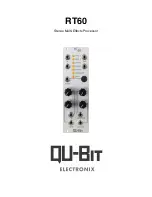
9
8. HI: This lets you tune the high range of the audio spectrum (4.5 kHz upwards) from +/- 15 dB with a
slope of 18 dB / octave. The 3rd order structure “keeps” the circle of influence within the filter’s audio band
so as not to overlap with the MID filters. This makes adjustment of the higher frequencies more accurate.
9. MID: This acts on frequencies within a wide mid range centered on 700 Hz, with amplification or
attenuation of +/- 12 dB.
10. LOW: This lets you adjust the signal’s low frequencies, amplifying them by +12 dB up to 100 Hz, or
reducing them by -14 dB up to 80 Hz with a slope of 12 dB / octave. The higher order prevents the low
frequencies from overlapping with the MID, making adjustment of the lower frequencies more accurate.
The HI, MID and LOW controls all have a detent at their mid positions. This indicates the filter’s “flat”
position.
11. AUX 1: This AUX SEND is postfade (it depends on the fader position) and is used to define the amount
of signal sent to the internal reverb unit and to the master section’s AUX 1 OUT. This is useful for managing
internal or external effects (see Master Section, 2).
12. AUX 2: This AUX SEND is prefade (it does not depend on the fader position) and sets the amount of
signal sent to the master section’s AUX 2 OUT. This is useful for controlling a stage monitor (see Master
Section, 4).
13. PAN:
The PAN pot lets you send the signal to the LEFT or RIGHT MASTER channel. The pot’s
configuration has been designed to guarantee minimum noise and maximum dynamic in its central position.
14. MUTE: To exclude this channel signal from the L/R MASTER mix without changing the fader position,
simply press the MUTE button.
15. CHANNEL FADER: As on all mixing consoles, this lets you control the total amount of signal going to
the L/R MASTER.
16. VU LEVEL METER: This lets you “read” the amount of gain set.
Note: Turn up the GAIN control to a point where the orange “normal” section appears fully bright and the
red “peak” occasionally shows. But don’t worry too much about this: the amount of headroom from input
to output means that even strong overloads can be absorbed by the mixer’s electronics without resulting in
distortion.
MIC CHANNELS
9.
12.
14.
16.
8.
10.
11.
13.
15.






































